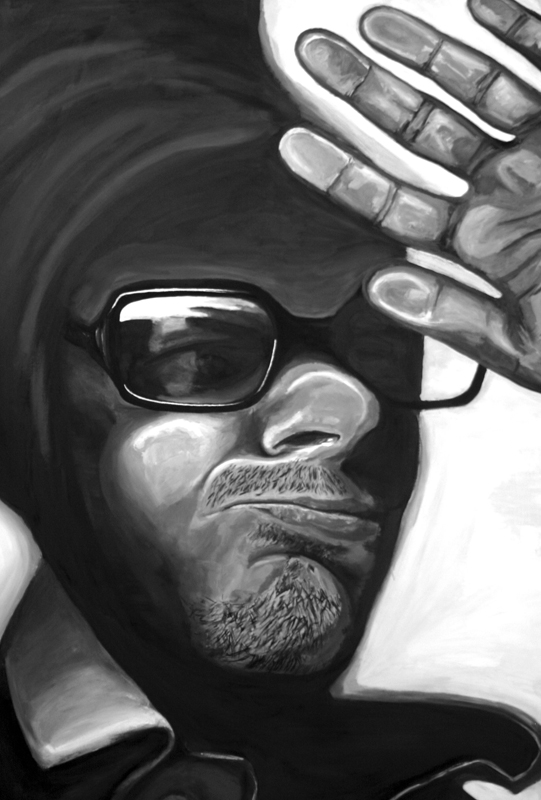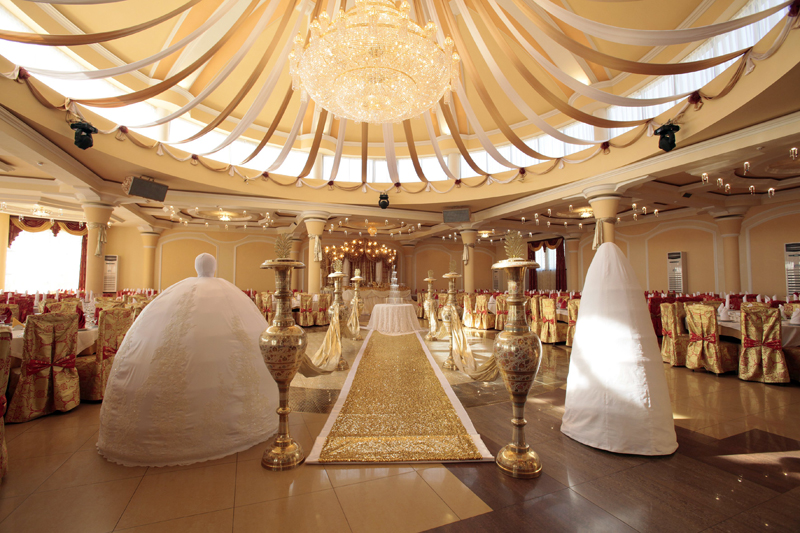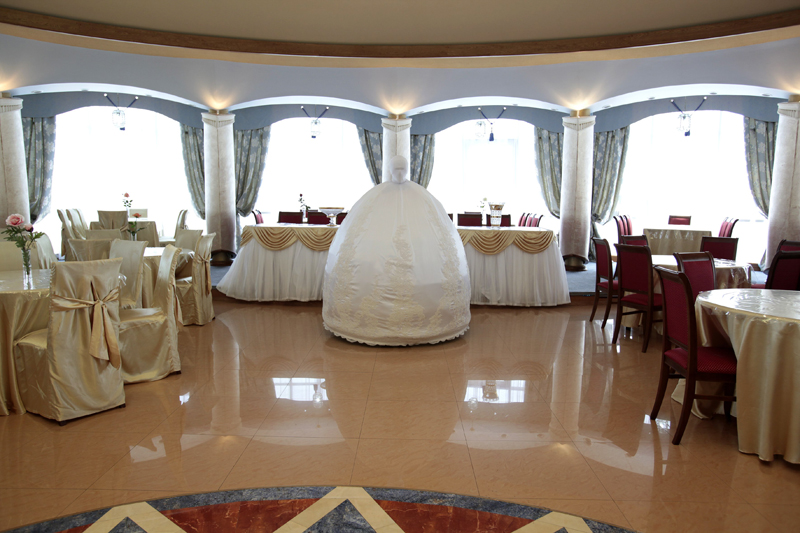The 4th International Baku Art Festival (Exhib. Review)
 The 4th International Biennale of Contemporary Art “Alüminium,” Shirvanshah Palace, Baku, Azerbaijan, December 11-17, 2009.
The 4th International Biennale of Contemporary Art “Alüminium,” Shirvanshah Palace, Baku, Azerbaijan, December 11-17, 2009.
The 4th International Baku Art festival opened among the vaults and minarets of the event’s main venue, the Shirvanshah Palace, one of a handful examples of fifteenth-century Islamic architecture.
Housed at multiple venues around the city, including the hulking former Museum of Lenin (now State Carpet Museum),the festival showcased works by 65 contemporary artists from Central Asia, Russia, Europe, and the United States.
Around the city of Baku, a battle has unfolded between desires to update past glory, or to enter the globalized world and catch up with its consumption race. Since the eleventh century Baku has been an important trade post along the Silk Road, which shaped its traditional culture in Zoroastric, Christian, and Islamic traditions. The cultural cross-roads this fertile mountain country, Azerbaijan went into socio-economic decline under the Soviet system, taking with it the Azeri cultural scene.
Only after the fall of the Soviet Union did the country regain control of its oil resources, and vast sums of money poured back into the local economy. An overheard remark that oil drips from every corner of a new building proved to be true when looking at Baku’s ostentatious private residencies and trendy boutiques. Furthermore, historical architecture was badly restored so that it lost its authenticity. As in other oil-producing nations, Azeri industrialists aspire to promote contemporary art, which is in its fledging state.
The festival’s curator since its start eight years ago, Leyla Akhundzadeh (who also curated the Azerbaijani pavilion at the 52nd Venice Biennale) this year collaborated with Dilara Vagabova, and the two have followed the bureaucratic protocols of the city officials and Ministry of culture who fund the Biennale.
 A grim prophesy, the Biennale’s title, Apocalypse or Universal Harmony: 2012, reflected on the commonly anticipated global shift. But in fact the theme described the city being drained of its cultural and historical lifeblood. Azerbaijan lost much of its creative capital when the intelligentsia fled after the bloody Nagorno Karabakh conflict in 1994. Those who stayed, homeless and displaced by the thousands, raised their children without proper homes or educations. This generation of artists could have added more creative, contemporary methods to the local art scene, who were lured into the Russian capital by its opportunities. Given this reflection, it is surprising that the festival didn’t make provisions for local artists, with only 15 in number shown.
A grim prophesy, the Biennale’s title, Apocalypse or Universal Harmony: 2012, reflected on the commonly anticipated global shift. But in fact the theme described the city being drained of its cultural and historical lifeblood. Azerbaijan lost much of its creative capital when the intelligentsia fled after the bloody Nagorno Karabakh conflict in 1994. Those who stayed, homeless and displaced by the thousands, raised their children without proper homes or educations. This generation of artists could have added more creative, contemporary methods to the local art scene, who were lured into the Russian capital by its opportunities. Given this reflection, it is surprising that the festival didn’t make provisions for local artists, with only 15 in number shown.
 There is a lack of both education and infrastructure for contemporary art. The existing art schools still operate along curricula inherited from the Soviet system, so that, with an emphasis on realism, the local artists were not exposed to newer contemporary practices such as video art. Yet several local artists offered a possible balance. Taus Makhacheva, originally from Dagestan, who studied at Goldsmiths, University of London, and now lives in Moscow, presented two haunting videos. The Karakul (2007) which was shot in Dagestan, evoked the close relationship of people to the land in Azerbaijan where 50% of the land is arable. The artist disguised herself as a half-human, half-animal by wearing a fitted body suit made out of a young lamb skin (karakul) that covered even her eyes and hands. By highlighting the connections between the two bodies,Makhacheva investigates a rediscovery of our forgotten relationship with nature.
There is a lack of both education and infrastructure for contemporary art. The existing art schools still operate along curricula inherited from the Soviet system, so that, with an emphasis on realism, the local artists were not exposed to newer contemporary practices such as video art. Yet several local artists offered a possible balance. Taus Makhacheva, originally from Dagestan, who studied at Goldsmiths, University of London, and now lives in Moscow, presented two haunting videos. The Karakul (2007) which was shot in Dagestan, evoked the close relationship of people to the land in Azerbaijan where 50% of the land is arable. The artist disguised herself as a half-human, half-animal by wearing a fitted body suit made out of a young lamb skin (karakul) that covered even her eyes and hands. By highlighting the connections between the two bodies,Makhacheva investigates a rediscovery of our forgotten relationship with nature.
Her other video, Space of Celebration (2009), addresses the new culture of consumption displayed through excessive marriage rituals, such as a place setting for a thousand guests.
Touching on similar themes, but with less success, are the representational paintings by the self taught, Baku-based artist Farid Rasulov. His works mock a society where monetary wealth is becoming a priority. Facing forward against a blue background, the artist cradles a flamingo–a trophy perhaps-in the crook of his arm.
Several international artists found the festival’s theme a productive environment. Uncertainty about the future of mankind emanated from New Camouflage (2008), an installation by Vibha Galhotra. The artist collaged the photographs of her native Delhi. The installation consisted of a myriad of copies of city images taken from the top of a mosque, Jama Masjid, which the artist shot and montaged onto the wall. The artist included four mannequins of soldiers, positioning them close to the wall. The panoramas of the city were silkscreened onto the mannequins’ fatigues to communicate the idea of the inhabitants being an intrinsic part of the megalopolis struggling with overpopulation and pollution.
Compared to most biennales, the week-long festival was short and limited the potential merging of cultures, and the educational opportunities that these events provide. For the curators Akhundzadeh and Vagabova, the cause for this brevity was a misappropriation of funds, and this reduced the event to a succession of exhibition openings and networking hype. The fact that many of the works were unrelated to the local context was also a disadvantage. An educational platform where talks and discussions take place, along with site-specific art projects are feasible steps to make this event more productive in the future.
If only the efforts and ambitions that went into the opening of the stunning Museum of Modern Art in Baku could have been directed to support the fledgling local contemporary art scene. Instead, the space has been filled with local art that fits the taste of local industrialists. There are also plans to build a branch of the Guggenheim, turning the city into the equivalent of Bilbao or “Baku-bao.” The officials seem to have forgotten that contemporary art depends more on artists and education than bricks and glass.













